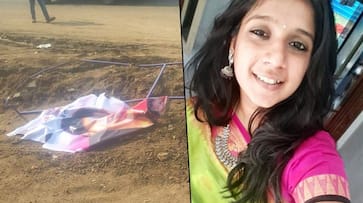The death of a techie, who came under the wheels of a lorry after a banner fell on her, has shaken Tamil Nadu, throwing light on the cutout culture that found its roots in the film-politics nexus of the state
There is a famous RK Laxman cartoon in the early 90s. In a mid-air flight, one of the occupants of the plane says, "I think we are over Tamil Nadu", and his companion asks, "how do you say that?" He replies, "I can spot the cutouts even from here."
Well, the first half of the 1990s in Tamil Nadu, when J Jayalalithaa was the chief minister, the 'cutout culture' really took firm roots in the state, and it was one of the infamous defining features of her regime that was marked by many excesses.
And now a techie has been killed in Chennai after a cutout erected for a wedding in the family of the ruling party politician fell on her and she, in turn, slipped from the two-wheeler she was on and was run over by tanker.
The young woman's death has shaken the entire state, and the high court castigated the political parties for encouraging the banner culture, despite various court orders against it.
Also watch: Ban the banner: With images of politicians crashing, here’s what you should know about hoardings
"The officials, who are sucking the blood of the people, are more loyal to a party than to the government," a bench of the high court said today.
The strong observations from the high court while welcome should be read in the context that the state has done precious little to end the cutout culture despite the court explicitly banning it.
In 2017, the Madras high court banned such displays through cutouts, and asked the government to ensure that "photos or pictures of such persons who are alive shall not be depicted by way of those banners, flex boards, sign-boards."
But both politicos and film stars have blissfully looked elsewhere, when their cadres and fans flout the rules flagrantly.
Recently, ahead of his film's release, a 215 feet cutout of actor Suriya was erected. The actor, who otherwise projects himself as a socially aware individual, however, remained silent on this obvious breaching of law.
Also read: Chennai hoarding death: Madras HC says tired of passing orders against illegal boards
While cutouts and huge banners for film stars have been the norm in almost all states, it is Tamil Nadu that pioneered the cutout culture for politicos.
Well-known political theorist Partha Chatterjee once said, “wall writing regardless of parties was the single most visible material sign of political activity in the state. The activity used and perfected for over more than half a century, became an essential aspect of West Bengal’s political culture, in the same way that giant cutouts characterize the public political culture of Tamil Nadu”.
Cutout culture, many academics opine, is a direct offshoot of the strong nexus between politics and films in Tamil Nadu. Politics quickly borrowed the visual aesthetic of the cinema publicity because the leaders of that time, like Annadurai, M Karunanidhi and MG Ramachandran, owed their rise in popularity to their film career. The cutout, by their lurid colours and gargantuan size, helped project a literal larger-than-life-image for these politicos. And they held on to it strongly.
When Jayalalithaa became the chief minister for the first time in 1991, she took it to new heights, both literally and figuratively. The kitschy cutout culture became a kind of insignia of her regime then, and because of its notoriety, it quickly spread to other states.
Now, after the horrendous death of the techie Subasri, politicians across the spectrum in Tamil Nadu have issued statements urging their cadre to refrain from putting out such huge cutouts and banners.
But this is too little and too late. At the risk of sounding like an inveterate cynic, one should say that things don't look like getting better.
Two years ago, one person in Coimbatore was killed because of a big banner. Then too politicos promised big, but nothing really changed at the ground level. This is a recurrent phenomenon in the State. Publicity hungry politicos and pliant officialdom have ensured that the roads are not actually 'cut out' for the public.
Last Updated Sep 14, 2019, 5:38 PM IST









![Salman Khan sets stage on fire for Anant Ambani, Radhika Merchant pre-wedding festivities [WATCH] ATG](https://static-gi.asianetnews.com/images/01hr1hh8y86gvb4kbqgnyhc0w0/whatsapp-image-2024-03-03-at-12-24-37-pm_100x60xt.jpg)
![Pregnant Deepika Padukone dances with Ranveer Singh at Anant Ambani, Radhika Merchant pre-wedding bash [WATCH] ATG](https://static-gi.asianetnews.com/images/01hr1ffyd3nzqzgm6ba0k87vr8/whatsapp-image-2024-03-03-at-11-45-35-am_100x60xt.jpg)


